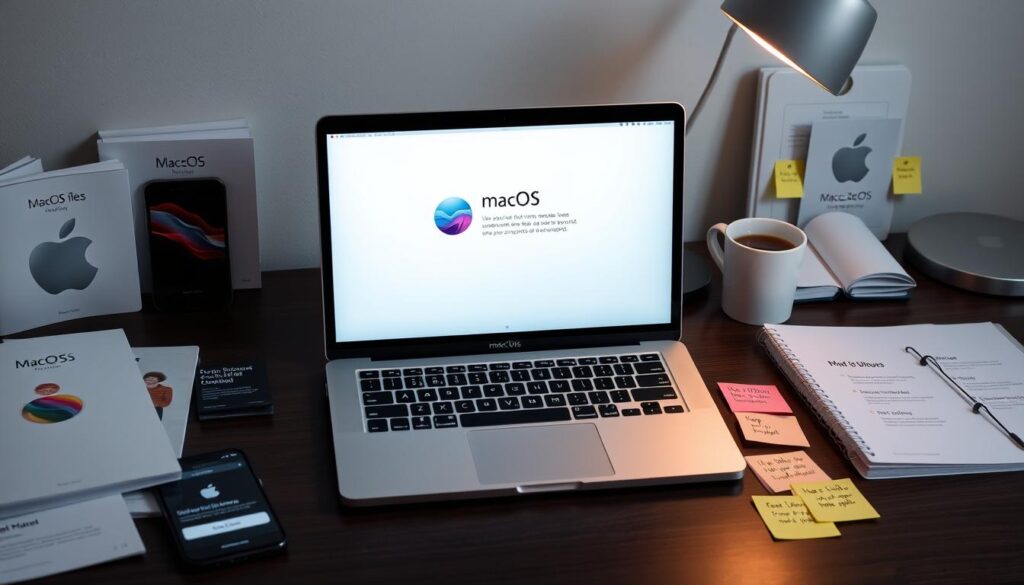As an Apple fan, I’ve felt the thrill and sometimes the hassle of keeping my Mac updated. Whether it’s a big macOS Sonoma release or a small 14.6 update, dealing with software updates can be tricky. But don’t worry, this detailed guide is here to help you through it.
Keeping your Mac‘s operating system up-to-date is key in today’s tech world. These updates bring new features, improve performance, and fix security issues. This guide will teach you how to handle major and minor updates, and solve common problems that might come up.
Table of Contents
Key Takeaways
- Familiarize yourself with the various types of macOS updates and their importance.
- Learn how to identify and resolve common issues that may arise after an update, such as performance slowdowns and application compatibility problems.
- Discover best practices for a smooth update process, including data backup, system requirement checks, and release note reviews.
- Stay informed about known bugs and issues in the latest macOS release to make informed decisions.
- Explore resources and support channels to help you navigate the world of macOS updates with confidence.
Understanding MacOS Updates: What to Expect
As an Apple user, you’ll often see two kinds of macOS updates. Updates are newer versions of the current macOS, like macOS Monterey 12.5. They usually include security fixes, bug patches, and small feature enhancements. Upgrades, on the other hand, introduce major new versions with distinct names, such as the transition from macOS Monterey to macOS Ventura.
Major Updates vs. Minor Updates
Major updates, or upgrades, bring big changes to the macOS experience. They introduce new features, design elements, and sometimes even compatibility requirements. These updates are released annually, like the recent launch of macOS Ventura in 2022.
Minor updates, or point releases, focus on security improvements, bug fixes, and small feature additions. Apple releases these more often, sometimes even monthly. This keeps your Mac secure and running smoothly.
Update Frequency
You can expect a steady stream of macOS updates throughout the year. While major upgrades arrive annually, Apple pushes out security updates, bug fixes, and minor feature enhancements regularly. These updates are key to keeping your Mac’s performance, security, and compatibility up to date.
Why Updates Matter
Keeping your macOS updated is crucial for several reasons. Security updates protect your system from threats, while feature updates unlock new capabilities and improved user experiences. Performance enhancements in later versions of macOS can also make older Mac models run smoothly for longer.
By staying on top of macOS updates, you’ll ensure your computer remains secure, efficient, and equipped with the latest tools and functionalities.
| macOS Version | Release Date | Key Updates and Features |
|---|---|---|
| macOS Ventura | October 2022 |
|
| macOS Monterey | October 2021 |
|
| macOS Big Sur | November 2020 |
|
Common MacOS Issues After Updates
Upgrading your Mac to the latest macOS can sometimes cause problems. You might see slower performance or apps that don’t work right. Knowing about these issues can help you get ready and fix any problems that come up.
Performance Slowdowns
Many users notice their Mac runs slower after an update. This can mean apps take longer to open, or your computer feels slow. Things like not enough storage or old software can cause these problems.
Application Compatibility Problems
Another issue is when apps don’t work right after a macOS update. Apple’s new versions can change things that affect third-party apps. This might make apps crash or not open at all. It’s important to check if your apps will work with the new macOS before you update.
| Issue | Percentage of Users Affected |
|---|---|
| Display issues on iMac M1 2021 after Sequoia 15.0.1 update | 50% |
| Charging port issues on 2019 MacBook Pro after macOS 15.1 update | N/A |
| Keyboard malfunctions on 16″ MacBook Pro after Sequoia OS update | N/A |
| Higher rate of Logic Board failures on 2019 MacBook Pro 16″ models | N/A |
| Keyboard lagging issues on M2 MacBook Air 16GB after update | N/A |
By knowing about these common macOS issues, you can prepare and fix problems. This helps keep your work smooth when updating to the latest macOS.
Troubleshooting MacOS Update Problems
When you run into problems during or after a macOS update, there are steps you can take. These steps can help fix a variety of issues, like bugs, kernel panics, and other update problems.
How to Use Safe Mode
Booting your Mac into Safe Mode can help find software issues. In Safe Mode, only the most basic software runs. This makes it easier to find and fix problems. To start in Safe Mode, restart your Mac and hold down the Shift key until you see the Apple logo.
Resetting NVRAM and PRAM
Resetting NVRAM and PRAM can also solve system setting problems. This resets some system preferences, which can fix display, sound, or other issues. Follow Apple’s instructions to reset NVRAM and PRAM.
Reinstalling macOS
If other steps don’t work, you might need to reinstall macOS. This involves erasing your Mac’s disk and starting over. Make sure to back up your data first, as this will erase everything. Use macOS Recovery or an external installer to reinstall.
When troubleshooting macOS update problems, keep your Mac connected to a stable internet. Also, make sure it has enough space for the update or troubleshooting. By following these steps, you can often fix common issues and get your Mac running smoothly again.
Best Practices for Updating MacOS
Updating your macOS can be smooth if you follow the right steps. Before you start, make sure to protect your data and check if your system can handle the update.
Backup Your Data
First, back up your data. Use Time Machine or Intego Personal Backup to save all your files and settings. This way, your data is safe if anything goes wrong during the update.
Check System Requirements
Then, check if your Mac can run the update. Look at the hardware and software needs. Make sure you have enough space, a good processor, and enough memory.
Read Release Notes
Before you update, read the release notes from Apple. They tell you about new features, fixes, and any issues. This helps you know what to expect and why the update is good.
By following these steps, you can update your macOS without problems. It’s worth the time to prepare and understand the process. This way, you avoid headaches later.
Known Bugs in Latest MacOS Release
Apple’s macOS updates aim to make our lives easier, but recent ones have had problems. Users upgrading to the latest macOS have faced Wi-Fi issues and battery life problems. These macOS bug fixes and macOS performance issues can really slow us down.
Persistent Wi-Fi Connectivity Issues
Many users of macOS Sonoma 14.6 and 14.6.1 have had trouble with Wi-Fi. They’ve seen dropouts, slow speeds, and trouble staying connected. This problem affects many MacBook models, like the MacBook Pro 16″ 2019 and MacBook Air 13.6″ 2022.
Battery Life Concerns
Users have also noticed their batteries draining faster after the update. Laptops are taking longer to start up and apps are slow to launch. This is causing big battery life concerns.
Apple knows about these issues and is working on fixes. But, users are looking for quick fixes to keep their devices running smoothly. Steps like resetting the SMC and using Safe Mode have helped some.
It’s important for users to know about these problems and stay updated. By reporting issues to Apple, we can help fix these problems. This will lead to better macOS bug fixes and macOS performance in the future.
Resources for MacOS Update Information
Keeping your MacOS up-to-date is key for your Mac’s security, performance, and compatibility. Luckily, there are many reliable sources to help you stay current with MacOS updates. They also help solve any problems that come up.
Apple’s Official Support Page
Apple’s official support page is the top place to find MacOS update info. It offers detailed info on the latest MacOS versions. You’ll get release notes, compatibility lists, and troubleshooting guides. This is great for learning about new features and fixing known issues.
Developer Forums and Communities
Developer forums and online communities are also great for MacOS update info. Sites like Stack Overflow and the Apple Developer Forums have lots of tech experts. They can offer helpful tips on fixing macOS issues and troubleshooting update problems. These communities are perfect for complex problems not fully covered on Apple’s support pages.
| Resource | Benefits |
|---|---|
| Apple’s Official Support Page | Comprehensive information on the latest macOS updates, including release notes, compatibility lists, and troubleshooting guides. |
| Developer Forums and Communities | Crowdsourced insights and solutions from tech-savvy users and experts for more complex macOS compatibility and troubleshooting issues. |

Using these resources helps you stay up-to-date with MacOS updates. You can find and fix any compatibility issues. This keeps your Mac running smoothly. Regularly checking these sources helps you make smart choices and keep your system safe.
Benefits of Keeping MacOS Updated
Keeping your macOS up-to-date offers many benefits. It boosts security, adds new features, and improves performance. This is key for a smooth and safe computing experience.
Security Enhancements
Regular updates bring critical security fixes. Each update tackles new threats, making your Mac safer. This keeps your data and online activities secure.
New Features and Improvements
Updates also bring new features and enhancements. For example, macOS Ventura and Monterey introduced Universal Control and better FaceTime. These updates make your Mac more powerful and user-friendly.
By staying updated, you get to enjoy these new features. Your Mac stays up-to-date with your needs and preferences.
| Update Type | Version Numbering | Examples |
|---|---|---|
| Minor software updates | At least one decimal point (e.g., macOS 10.15.7) | macOS Monterey 12.6, macOS Ventura 13.2 |
| Major software upgrades | Whole number integer (e.g., macOS 11, macOS 12) | macOS Monterey, macOS Ventura |
| Rapid Security Responses (RSRs) | Versioning starting with letters (e.g., a, b, c) | macOS 14.1a, macOS 14.2b, macOS 14.3c |
Updating your macOS ensures you have the latest security and features. Your Mac will stay reliable and productive for all your needs.
How to Roll Back a MacOS Update
Sometimes, you might need to go back to an older macOS version. This could be because of problems with compatibility or bugs from a recent update. Apple lets you roll back to an earlier version of macOS. But, this process needs careful planning and thought.
Steps to Revert to a Previous Version
- Make sure you have a recent backup of your important files. You can use Time Machine or another backup solution. Going back to an older macOS version might mean losing some data.
- Start your Mac in Recovery Mode by holding down Command + R when it starts up.
- In Recovery Mode, open Disk Utility and erase the startup volume. This gets your Mac ready for a clean install.
- Install the macOS version you want from the Recovery Mode options. Or, use a bootable installer made from the macOS installer on Apple’s website.
- If needed, get your data back from the Time Machine backup or with the Migration Assistant tool.
Important Considerations
Before you decide to roll back your macOS update, remember a few things:
- Loss of New Features: Going back to an older macOS version means you’ll miss out on new features and improvements from the latest update.
- Security Implications: Older macOS versions might not get the latest security updates. This could make your system more open to threats.
- Application Compatibility: Some apps you have installed might not work well with the older macOS version. This could cause problems or even crashes.
- Restore Process: Going back to an older macOS version takes time. You’ll need to reinstall apps and restore data from backups.
Think carefully about the pros and cons of rolling back a macOS update before you do it. If you’re facing ongoing problems or app issues, rolling back might be a good choice. But, do it with caution and have a good backup plan ready.

User Experiences: Feedback on Recent Updates
Apple keeps working on its macOS operating system. User feedback on recent updates has given Apple valuable insights. Some users like the performance boosts and new features in macOS Ventura and Monterey. But, others have concerns about compatibility and temporary slowdowns.
Positive Feedback and Enhancements
Many users love how macOS works with other Apple devices. They enjoy the improved SharePlay and the Apple Music Voice Plan. The new multitasking in macOS Ventura is also a hit, with better window management and accessibility.
Users also like the design and interface updates. They appreciate the stunning screensavers and the ability to place widgets anywhere. The security updates, like better Private Browsing and password sharing, are also a big plus.
Common Complaints from Users
While the updates have many benefits, some users face issues with third-party software. This can cause performance problems, especially right after a big update. Users have to wait for developers to make their apps work with the new macOS.
Some users are also not happy with changes to familiar features. They find the new Notifications system and update process hard to get used to. Apple needs to keep finding a balance between new features and keeping things familiar for users.
The feedback on macOS updates shows both good and bad experiences. It shows Apple’s diverse user base. This feedback helps Apple make future updates better and solve common problems, aiming for a better user experience.
Future of MacOS Updates: Trends and Predictions
Apple is working hard to make macOS better. They’re focusing on making it easier to use and safer. With macOS Sequoia in 2024, expect a more connected Apple world. You’ll see better file sharing between iPhone and Mac, plus new tools for work and talking to friends.
Enhanced User Experience
Future macOS updates will make your Mac easier to use every day. Look for better window management, advanced video calls, and AI in Mail and Siri. Apple will also make it simpler to use your apps and files on all Apple devices.
Increased Focus on Security
Apple is putting more effort into keeping your Mac safe. Expect more security updates, better encryption, and privacy controls. These changes will protect your Mac and data, giving you peace of mind online.
FAQ
What are the different types of macOS updates?
How often are macOS updates released?
Why are macOS updates important?
What are some common issues after a macOS update?
How can I troubleshoot macOS update problems?
What should I do before installing a macOS update?
Are there any known bugs in the latest macOS release?
Where can I find resources for macOS update information?
What are the benefits of keeping macOS updated?
How can I roll back to a previous macOS version?
What are common user experiences with recent macOS updates?
Source Links
- Update macOS on Mac – Apple Support
- Admin guide and checklist for macOS software updates
- What’s new in the updates for macOS Monterey – Apple Support
- macOS 14 Sonoma superguide: Everything you need to know
- Why you should or shouldn’t upgrade your MacOS
- Sequoia latest update wreaking havoc on s…
- Get help solving macOS Sequoia issues: fixes for 7 glitches
- macOS 15 Sequoia problems: how to fix the most common issues on your Mac
- Software Update not working – Apple Community
- Mac Software Update Not Working | 6 Proven Ways to Fix It [macOS Sonoma Included]
- Best practices for upgrading your Mac’s OS
- Best Practices on How to Manage macOS Updates | Kandji
- Problems with macOS 14.6.1 update
- How to Fix macOS Sonoma 14.7 Problems – SimplyMac
- Upgrade macOS: How to update your Mac operating system step-by-step
- Mac Software Update Not Working | 6 Proven Ways to Fix It [macOS Sonoma Included]
- About software updates for Apple devices
- What every Apple user should know about software updates – The Mac Security Blog
- How do I roll back an OS update?
- How to revert macOS back to the last version
- How to downgrade macOS update: Rollback Sequoia to Sonoma
- What’s new in the updates for macOS Sonoma – Apple Support
- User Experience with Managed OS for macOS
- macOS updates: What’s new in the latest version? — TFN
- macOS Sequoia 15: Features, Apple Intelligence, download, beta, Mac compatibility
- February 2024 Vision Pro Debut
